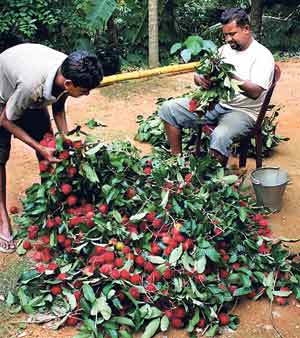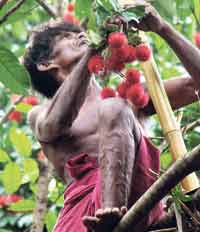
From Malaysia to Malwana – the Rambutan route
The Rambutan belt, which roughly begins around Biyagama, extends all the way to Hanwella, but the heartland of Rambutan country is Malwana, about 15 km northeast of Colombo along the Kelani river. Miles and miles of Rambutan trees laden with fruit line the streets. Some belong to farmers who own acres and acres of fruit laden trees, some are parts of the gardens of Malwana’s residents. First stop: the farm of T. Jayasena, one of the big cultivators of the fruit. The sprawling farm which spreads over three and a half acres of land with over a 100 trees, is situated on a slope. We met Jayasena’s three sons, who spoke to us as Jayasena himself was unavailable. The Jayasena family cultivation harvests four varieties, “Java”, the yellow “ela” variety, the “diga” variety and the “Malwana special”. “The trees are about 12 years old,” said the second son of Jayasena, declining to give his name, insisting that it was their father who is responsible for the plantation. According to him Malwana has been home to Rambutan for as long as he can remember.
Harvesting was in full swing when we entered the plantation, with around 10 people taking part in the activity. Nimble climbers were atop the trees, picking the fruits and dumping them into baskets that were perched on the branches. When the basket is full of fruit it is lowered to the ground where a few others gather any fruit that has fallen to the ground and remove any unwanted twigs and leaves and take the fruit to be sorted and packed for the merchants. The red variety, the Malwana Special, is the most wanted, said both the growers and the merchants, explaining that people look for the reddish and roundest fruits when buying, even though the yellow variety is the sweeter of the two. Our next stop was at the plantation of N. Gamini who was the lease hold owner of that particular plantation. He reaps the harvest from two and a half acres of Rambutan plantation which he has taken on lease from the owner for a period of two months for Rs 600,000. During the two months he is entitled to any and all the fruit that the trees bear so farmers like him hope for as large a harvest as possible, Gamini explained. Lights have also been rigged up all over the plantation to chase away the bats. During the day the harvest is under threat from squirrels, crows and other birds. Since sound as well as light drives these menaces away, the plantation also has a network of “takas” (tins with a piece of metal inside which produces a sound) that are all interconnected. When the central cord is tugged, the din that it creates scares away the birds and animals that cause harm to the precious fruits. The farmers have also started using fire crackers at intervals throughout the day, the Jayasena brothers told us. Merchants in search of this sweet and succulent fruit flock to Malwana from all corners of the country. We spoke to P. Duminda from Colombo, a railway worker, who sells Rambutan when it is in season to earn some extra cash. Close to 10,000 fruits, which were ordered from the Jayasena plantation were assorted into the back of a three wheeler, ready to be sent to Colombo. A truck packed with 30,000 Rambutans was also making its way to Akkaraipatthu in the Eastern Province, showing that the taste for Rambutan is universal within Sri Lanka. The fruits are sold at around Rs 3.50 by the farmers and according to the merchants, it is re-sold anywhere between Rs 6.00 – Rs 9.00 around the country. |
|
||
| || Front
Page | News
| Editorial
| Columns
| Sports
| Plus
| Financial
Times | International
| Mirror
| TV
Times | Funday Times|| |
| |
Copyright
2007 Wijeya
Newspapers Ltd.Colombo. Sri Lanka. |
 MALWANA -- Mini mountains of bright red and gold lining the streets of Colombo means one thing – the Rambutan season is here, once again. The much loved fruit makes its presence once a year and is a favourite among young and old. The Sunday Times FT decided to take a drive through Rambutan country last week to delve deeper into the life of the Rambutan.
MALWANA -- Mini mountains of bright red and gold lining the streets of Colombo means one thing – the Rambutan season is here, once again. The much loved fruit makes its presence once a year and is a favourite among young and old. The Sunday Times FT decided to take a drive through Rambutan country last week to delve deeper into the life of the Rambutan.  Bats are the bane of a Rambutan farmer’s life, Jayasena’s three sons say, adding that the arrival of the Rambutan season means literally, sleepless nights for the farmers. Rustic wooden huts have been set up around the platation, at strategic locations and it is from these that the farmers spend their nightly vigil.
Bats are the bane of a Rambutan farmer’s life, Jayasena’s three sons say, adding that the arrival of the Rambutan season means literally, sleepless nights for the farmers. Rustic wooden huts have been set up around the platation, at strategic locations and it is from these that the farmers spend their nightly vigil.